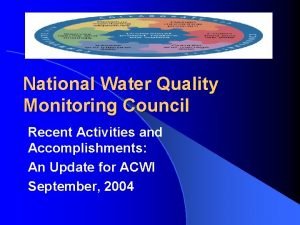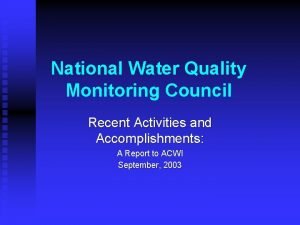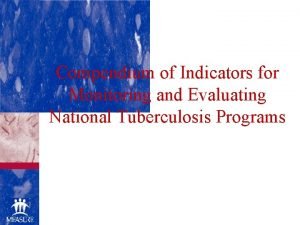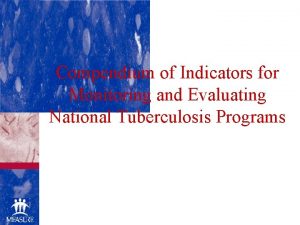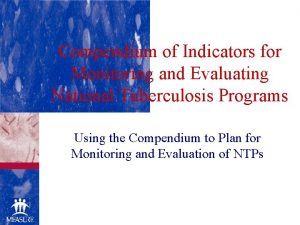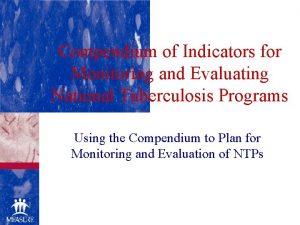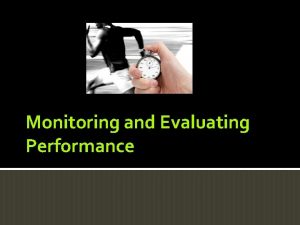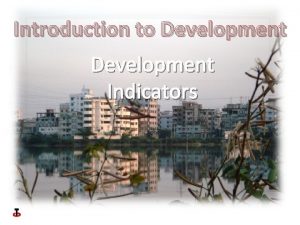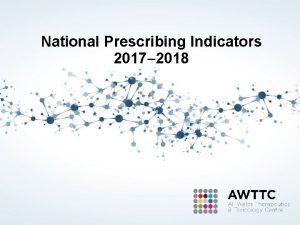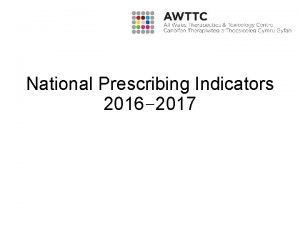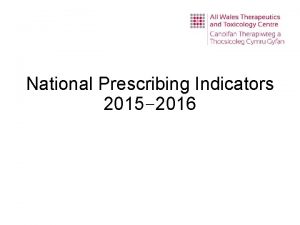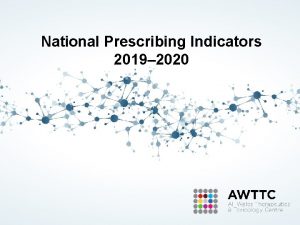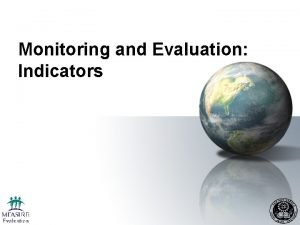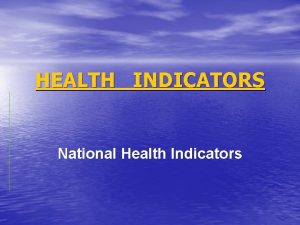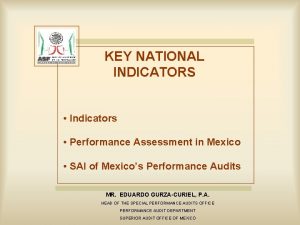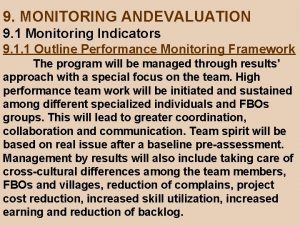Compendium of Indicators for Monitoring and Evaluating National























- Slides: 23

Compendium of Indicators for Monitoring and Evaluating National Tuberculosis Programs Using the Compendium to Plan for Monitoring and Evaluation of NTPs

Table of Contents • • • Introduction Defining M&E for National TB Programs Indicators Appendices

Indicator Selection • Detailed description for each indicator – Definition – What it measures – How to measure it – Data sources – Frequency and function – Strengths and limitations

Definition • • Type of indicator Numerator and Denominator Yes/No Brief review of criteria for assessment

What it measures • Relevance to program management – Identifying problems, solutions – Making decisions • Key program operation “captured” by the indicator • Possible interpretation of results – Is the NTP reaching its goals? – What does a low or high value mean for the NTP?

How to measure it • Source of numerator and denominator • Detailed criteria for assessment of qualitative indicators – Is it a “Yes” or “No”? • How to perform the calculation

Data sources • Census data • Monthly, quarterly and annual reports from each level of the NTP • Registers – cough/TB suspects, TB cases, laboratory • Treatment cards • Program documentation – Stock cards, distribution records, meeting reports, annual reports

Frequency and function • How often indicator should be reported – Monthly, quarterly, annually, every 2 to 3 years • Who should receive reports – Administrative levels within NTP – Donor agencies – Key partners in TB control activities • Monitoring or evaluation? – Appropriate use of indicator

Strengths and weaknesses • How accurately does the indicator measure achievement or implementation of a key DOTS component? • Are the data easy or difficult to locate? • Proceeding with caution…

Examples • Indicator 4. 1 – Surveillance of MDR-TB • Indicator 2. 2 – Case notification rate – new smear-positive pulmonary TB cases

Indicator 1. 4 Surveillance of MDR-TB Definition “The national TB-control program assesses the prevalence of MDR-TB at least once within a 5 -year period. This is a yes/no indicator. ” • Qualitative indicator (yes/no) • Basic criteria for determining response

What it measures • Availability of information on drug susceptibility • Program quality – Are treatment regimens effective? – Can the NTP estimate the burden of MDR-TB? – Can the NTP plan for DOTS-Plus program?

Data sources • Reports or other documentation of national or sub-national survey of MDR-TB following protocols and quality assurance recommended by WHO & IUATLD

Data sources • NTP data and reports

Frequency and Function • If “no”, indicator should be measured every year until it is a “yes”. • If “yes”, indicator should be periodically assessed (every 2 to 5 years) to ensure the activity continues • This indicator is appropriate for NTP program reviews.

Strengths & Limitations • Useful for planning and monitoring • Easy to measure BUT… • Quality of MDR-TB surveillance? • Limited policy/NTP response to finding of MDR-TB

Indicator 2. 2 Case notification rate-new smear positive pulmonary TB cases Definition “The number of new smear-positive pulmonary TB cases reported to the NTP per year per 100, 000 population. ” • Numerator & denominator • Calculation

What it measures • Information on burden of infectious cases • Detection of weaknesses in case detection and registration • Useful to describe trends – program coverage, prevalence, impact of HIV coinfection • Data for program planning • Useful to disaggregate by age group and gender

How to measure it • The numerator can be found in national level reports for the previous year • The denominator should be available from census data Ø Definition of “notified” may vary by context

Data sources • Quarterly reports on TB-case detection • Census statistics

Frequency & Function • This indicator should be calculated on an annual basis • This is a routinely reported indicator. Ø This may vary by context; annual reporting is the minimum.

Strengths & Limitations • Directly measures NTP capacity to identify infectious cases • Easy to compare trends over time • Objective measurement (sputum microscopy) BUT… • Represents only a subset of cases

Conclusions • Indicators are the “CORE” of the Compendium However, • Introduction/overview of M&E is also critical information • Appendices include tools to facilitate planning for M&E, data collection
 Compendium of sanitation systems and technologies
Compendium of sanitation systems and technologies Higher pe monitoring and evaluating
Higher pe monitoring and evaluating Perseverationsneigung
Perseverationsneigung Invasive species compendium
Invasive species compendium Aggranulozytose
Aggranulozytose Cabi compendium
Cabi compendium Cavilon creme compendium
Cavilon creme compendium Linear skin tear
Linear skin tear Ddi compendium
Ddi compendium Compendium catechism
Compendium catechism What is physiological indicators
What is physiological indicators National water quality monitoring council
National water quality monitoring council National water quality monitoring council
National water quality monitoring council Nwqmc
Nwqmc National water quality monitoring conference
National water quality monitoring conference National unification and the national state
National unification and the national state Kontinuitetshantering
Kontinuitetshantering Novell typiska drag
Novell typiska drag Tack för att ni lyssnade bild
Tack för att ni lyssnade bild Ekologiskt fotavtryck
Ekologiskt fotavtryck Varför kallas perioden 1918-1939 för mellankrigstiden?
Varför kallas perioden 1918-1939 för mellankrigstiden? En lathund för arbete med kontinuitetshantering
En lathund för arbete med kontinuitetshantering Kassaregister ideell förening
Kassaregister ideell förening Vilotidsbok
Vilotidsbok











